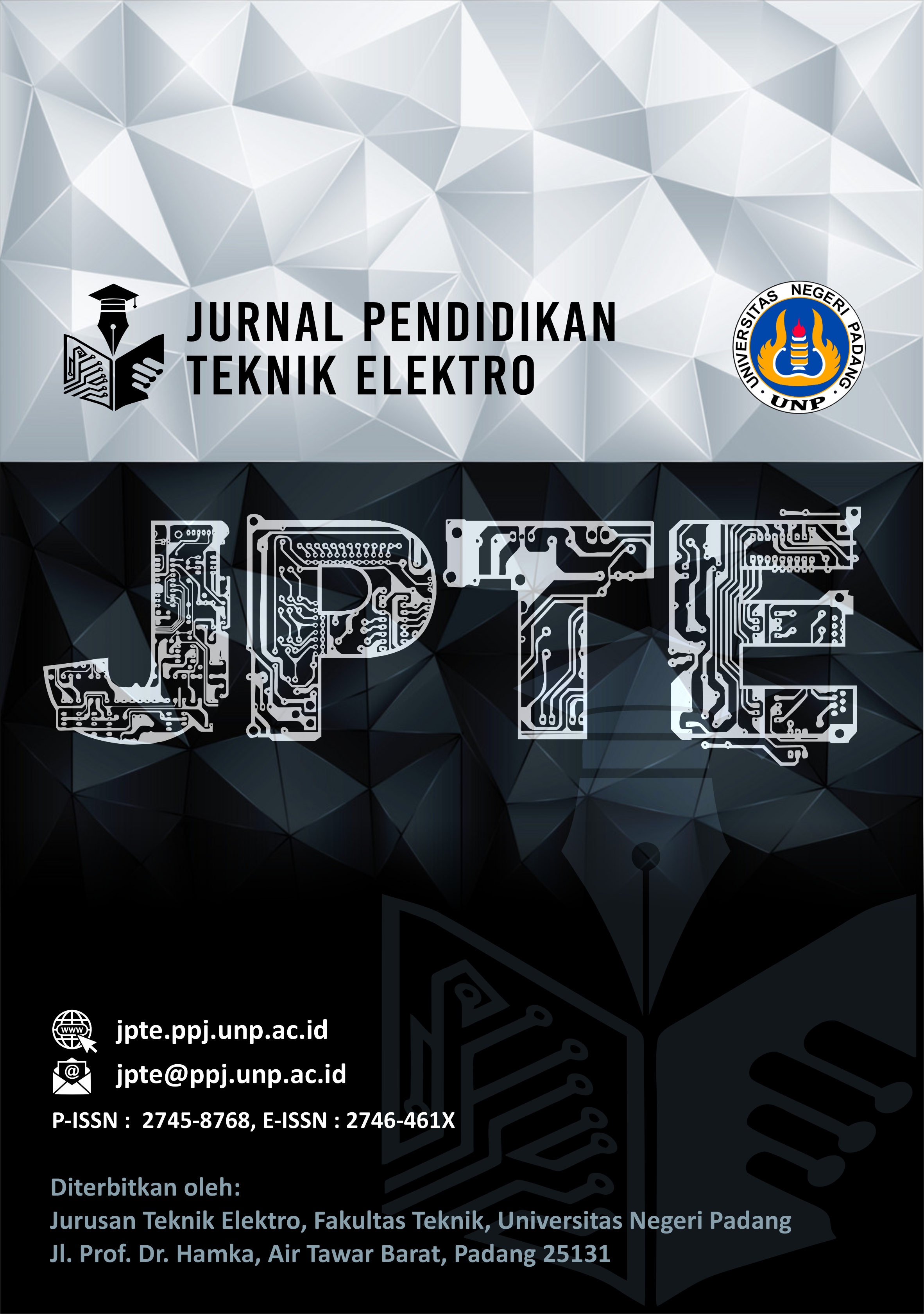Efektivitas Model pembelajaran Search, Solve, Create and Share (SSCS) Pada Mata Pelajaran Dasar Dasar Ketenagalistrikan
##plugins.themes.academic_pro.article.main##
Abstract
This research aims to determine the improvement in student learning outcomes by using the Search, Solve, Create, and Share learning model in the Basic Electricity subject in class X TITL 2 at SMK Negeri 2 Sungai Penuh. The minimum student completion criteria (KKM) score has not been achieved due to learning factors that are still teacher-centered or conventional, thus affecting the value of student learning outcomes in the cognitive aspect. This research uses experimental research with a pre-experimental method with a one-group pretest post-test design. The object of this research is a Search, Solve, Create, and Share (SSCS) based learning model on student learning outcomes in Basic Electricity subjects. The subjects of this research were class The instrument used in this research was a student test. Based on the results obtained, the average posttest score of students has exceeded the minimum completeness requirement. Therefore, applying a Search, Solve, Create, and Share (SSCS) based learning model in the Basic Electricity subject is effective because it improves student learning outcomes with an average N-Gain Score in the high category. The percentage of classical completeness scores obtained is also high and exceeds the minimum class completeness value that has been determined. Therefore, the application of the Search, Solve, Create, and Share (SSCS) learning model is considered to be able to improve student learning outcomes.
##plugins.themes.academic_pro.article.details##

This work is licensed under a Creative Commons Attribution 4.0 International License.
References
[2] S. Maskar and P. S. Dewi, “Peningkatan Kompetensi Guru Ma Darur Ridho Al-Irsyad Al Islamiyyah Pada Pembelajaran Daring Melalui Moodle,” Journal of Social Sciences and Technology for Community Service (JSSTCS), vol. 2, no. 1, p. 1, 2021, doi: 10.33365/jsstcs.v2i1.875.
[3] D. T. P. Yanto, M. Kabatiah, H. Zaswita, G. Giatman, and H. Effendi, “Development of Virtual Learning using Problem-Based Learning Models for Vocational Education Students,” ELINVO (Electronics, Informatics, and Vocational Education), vol. 7, no. 2, pp. 163–172, 2022, doi: 10.21831/elinvo.v7i2.52473.
[4] N. D. Puspaningtyas and P. S. Dewi, “Persepsi Peserta Didik Terhadap Pembelajaran Berbasis Daring,” Jurnal Pembelajaran Matematika Inovatif (JPMI), vol. 3, no. 6, pp. 703–712, 2020, doi: 10.22460/jpmi.v3i6.703-712.
[5] F. Supriadi, D. H. Wibowo, and C. A. Afgani, “Analisis Implementasi Kurikulum Operasional Satuan Pendidikan Berbasis Kemaritiman di SMK Negeri 1 Alas Kabupaten Sumbawa,” JIIP - Jurnal Ilmiah Ilmu Pendidikan, vol. 6, no. 1, pp. 421–434, 2023, doi: 10.54371/jiip.v6i1.1456.
[6] D. T. P. Yanto, Sukardi, M. Kabatiah, H. Zaswita, and O. Candra, “Analysis of Factors Affecting Vocational Students’ Intentions to Use a Virtual Laboratory Based on the Technology Acceptance Model,” International Journal of Interactive Mobile Technologies, vol. 17, no. 12, pp. 94–111, Jun. 2023, doi: 10.3991/ijim.v17i12.38627.
[7] M. Ichsan and H. Effendi, “Dampak Penggunaan Media Interaktif terhadap Hasil Belajar Siswa pada Mata Pelajaran Dasar-Dasar Ketenagalistrikan,” Jurnal Pendidikan Teknik Elektro, vol. 04, no. 02, pp. 444–451, 2023.
[8] A. Erwinsyah, “Manajemen Pembelajaran Dalam Kaitannya Dengan Peningkatan Kualitas Guru,” Tadbir: Jurnal Manajemen Pendidikan Islam, vol. 5, no. 1, pp. 69–84, 2017.
[9] M. Erlistiani, A. Syachruroji, and E. Andriana, “Penerapan Model Pembelajaran SSCS (Search, Solve, Create and Share) Terhadap Kemampuan Berpikir Kritis Siswa,” Jurnal PGSD: Jurnal Ilmiah Pendidikan Guru Sekolah Dasar, vol. 13, no. 2, pp. 161–168, 2020, doi: 10.33369/pgsd.13.2.161-168.
[10] B. Baharuddin and J. Dalle, “Transforming learning spaces for elementary school children with special needs,” Journal of Social Studies Education Research, vol. 10, no. 2, pp. 344–365, 2019.
[11] Hardani et al., Metode Penelitian Kualitatif dan Kuantitatif, no. Maret. 2020.
[12] I. Etikan, “Comparison of Convenience Sampling and Purposive Sampling,” American Journal of Theoretical and Applied Statistics, vol. 5, no. 1, p. 1, 2016, doi: 10.11648/j.ajtas.20160501.11.
[13] Soegiyono, Metode Penelitian Kuantitatif, Kualitatif dan R&D. 2011.
[14] D. T. P. Yanto, Ganefri, Sukardi, J. P. Yanto, R. Kurani, and Muslim, “Engineering Students’ Acceptance of Augmented Reality Technology Integrated with E-Worksheet in The Laboratory Learning,” International Journal of Online and Biomedical Engineering (iJOE), vol. 20, no. 03, pp. 39–54, Feb. 2024, doi: 10.3991/ijoe.v20i03.46101.
[15] S. Widodo et al., Metodologi Penelitian. 2023.
[16] S. Nurhalimah, Y. Hidayati, I. Rosidi, and W. P. Hadi, “Hubungan Antara Validitas Item Dengan Daya Pembeda Dan Tingkat Kesukaran Soal Pilihan Ganda Pas,” Natural Science Education Research, vol. 4, no. 3, pp. 249–257, 2022, doi: 10.21107/nser.v4i3.8682.
[17] J. A. Prieler and J. Raven, “Chapter 7 Problems in the Measurement of Change ( with Particular Reference to Individual Change [ Gain ] Scores ) and their Potential Solution Using IRT * Part I : Problems in the Measurement of Change,” vol. 11, no. 2002, pp. 119–150, 2008.
[18] O. Candra, C. Dewi, and D. Tri Putra Yanto, “The Implementation of Power Electronics Training to Enhance Student Learning Activities in the Power Electronics Learning Process.” [Online]. Available: www.ijicc.net
[19] J. Pendidikan, T. Elektro, W. Putra Perdana, and O. Candra, “Peningkatan Hasil Belajar: Efektivitas Model Project-Based Learning Pada Mata Pelajaran Instalasi Motor Listrik,” vol. 05, no. 01, pp. 101–106, 2024.
[20] O. Candra, F. Eliza, S. Islami, and Y. Alisman, “Pengembangan Multimedia Interaktif Mata Diklat Memperbaiki Motor Listrik Guna Peningkatan Hasil Belajar,” Perspektif Pendidikan dan Keguruan, vol. 10, no. 2, pp. 7–15, 2019, doi: 10.25299/perspektif.2019.vol10(2).3930.
[21] O. Candra and D. T. P. Yanto, “the Active Learning Strategy of Every Type Is a Teacher Here To Improve Student Learning Outcomes,” JURNAL PAJAR (Pendidikan dan Pengajaran), vol. 4, no. 3, pp. 616–623, 2020, doi: 10.33578/pjr.v4i3.7991.
[22] F. Mutiasari, R. Agustinsa, and N. A. Yensy, “Pengaruh Model Pembelajaran Search, Solve, Create, Share terhadap Kemampuan Pemecahan Masalah Matematika,” JKPM (Jurnal Kajian Pendidikan Matematika), vol. 9, no. 1, p. 59, 2023, doi: 10.30998/jkpm.v9i1.15152.
[23] R. P. Utami, “Pengaruh Model Pembelajaran Search Solve Create And Share (SSCS) dan Problem Based Instruction (PBI) terhadap Prestasi Belajar dan Kreativitas Siswa,” Bioedukasi, vol. 4, pp. 57–71, 2011.
[24] H. Susilo, A. Corebima, and S. Zubaidah, “Hubungan Kemampuan Berpikir Kreatif Dan Hasil Belajar Kognitif Pada Pembelajaran Search Solve Create and Solve Di Sma,” Hubungan Kemampuan Berpikir Kreatif dan Prosiding Seminar Nasional Biologi, no. February, pp. 978–602, 2016.

